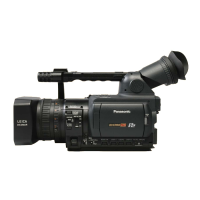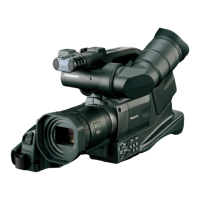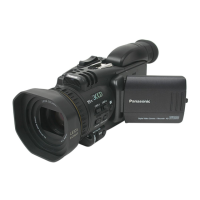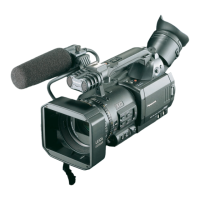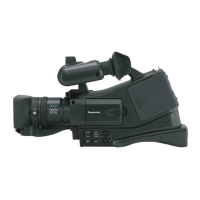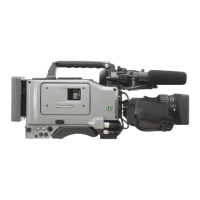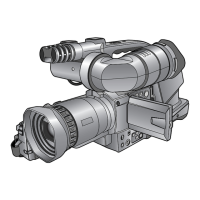Do you have a question about the Panasonic DVCPRO AJ-D410AP and is the answer not in the manual?
Details the 1/2" IT 3-CCD configuration, digital processing, replacement lens system, and CC/ND filter.
Describes the DVCPRO format, standard tape drive, high system capabilities, and other features.
Lists various accessories and components like microphones, viewfinders, lenses, and batteries.
Provides data for lens shading compensation based on lens classification.
Explains the POWER switch, VTR STBY/SAVE switch, and GAIN selector.
Details the OUTPUT/AUTO KNEE switch and WHITE BAL switch.
Describes buttons like BREAKER, JOG dial, MENU, RESET, MODE CHECK, QUICK FOCUS, FULL AUTO.
Explains AUDIO LEVEL controls, AUDIO IN switches, and rear mic power switches.
Details MIC IN, S-VIDEO OUT, AUDIO OUT, CAM OUT, GENLOCK IN, TC OUT, TC IN connectors.
Describes ECU connector, wireless slot, light shoe, shoulder belt fittings, and viewfinder stopper.
Explains the TALLY lamp and switch behavior.
Details REW/FF, STOP, PLAY/PAUSE, and EJECT buttons.
Step-by-step guide to attach and set up the AU-BP402 battery pack.
How to select the correct battery type in the sub-menu.
Instructions for attaching and setting up Anton Bauer battery packs.
Guide to attach and set up Sony NP-1B battery packs.
How to connect and use the AJ-B75 AC adapter for power.
Step-by-step process for mounting a lens onto the camera.
How to attach and detach the camera unit to a tripod.
Instructions for connecting viewfinder, microphone, and shoulder strap.
Guide to setting the unique Camera ID using the menu.
Instructions for setting the camera's internal clock.
How to adjust flange back for precise focus.
Detailed steps for performing white shading compensation for lenses.
Explains the meaning of REC, BATT, and VTR SAVE lamps.
Describes various status messages and icons shown on the viewfinder screen.
Explains what each display item means and when it appears.
Shows how to select which items are displayed in the viewfinder.
Displays for VTR warnings, battery status, and tape remaining.
Table showing how display items are mapped to status and selection.
Explains safety zone markers and other marker settings.
Step-by-step guide to perform automatic white balance adjustment.
Instructions for performing automatic black balance adjustment.
Details available shutter modes and their speeds.
How to set and adjust the synchro scanning mode for shutter speed.
How to set the user's bit for recording memos and information.
Guide to setting the time code (TCG, TCR, ETC, UBG, UBR, EUB, CNT).
How to lock the unit's time code to an external generator.
Steps to release the external time code lock.
Information on connecting and using the AJ-EC3P unit.
Details the VR center values for various controls on the AJ-EC3P.
Explains the purpose and use of scene files.
Guide to renaming scene files.
Instructions for selecting and writing/reading scene files.
Steps to reset scene filenames to their factory defaults.
Details the specific settings for each scene file type.
Lists selectable items for the file select function.
Steps to prepare and start normal recording.
How to ensure continuity between recorded scenes.
How to select audio sources like front/rear mics or line input.
Guide to manually adjust audio input levels for CH1 and CH2.
How to review the last few seconds of recording.
Explains INTERVAL REC, Still-picture, and Variable speed playback.
How to enable, disable, and navigate through the menu screens.
How to select sub-menu items and change settings.
Outlines the structure of the SCENE main menu.
Shows the organization of the MAIN 1/2 and MAIN 2/2 menus.
Details settings for SCENE FILE, NAME EDIT, WRITE, and INIT.
Explains settings for A.IRIS LEVEL, PEAK/AVE, SPEED, MASTER GAMMA, and color/skin tone.
Describes settings for H DETAIL, V DETAIL, DTL CORING, H.DTL FREQ, MATRIX, CHROMA LEVEL, PHASE, MASTER PED, KNEE POINT.
Covers file selection, read/write, and SW MODE settings like GAIN and ATW.
Explains VIDEO OUT, VIDEO OUT SEL, SET UP, TC MODE, UB MODE, FIRST REC TC, FF/REW SPEED, TC OUT.
Details TIME STAMP, INTERVAL REC, REC TIME, INTERVAL TIME, PAUSE TIMER, WIRELESS WARN.
Covers battery selection, type, and voltage level settings.
Details FRONT/REAR MIC POWER, MIC input levels, LOWCUT, LINE input, REAR SEL, LIMITER, CUE REC SEL.
How to select lens types for shading compensation.
Settings for SAFETY ZONE, CENTER MARK, ZEBRA1/ZEBRA2 DETECT, VF DTL.
Settings for FILTER, GAIN, WHITE BAL, COLOR TEMP, IRIS, ZOOM, TCG, LEVEL METER, TAPE REMAIN, BATTERY.
Settings for SHUTTER SPEED, IRIS (SPOT, BACK), AUTO/SCENE NAME, LOW LIGHT, TIME/DATE, EXTENDER.
Settings for !LED display and CAMERA ID.
How to set time/date and view diagnostic information.
Explains warnings for SLACK (motor issue) and BATTERY END.
Details warnings for REC WARNING (control signals) and TAPE END.
Explains warnings for RF (clogged heads), WIRELESS RF (weak signal), and BATTERY NEAR END.
Step-by-step guide to manually eject a cassette.
How to handle condensation and clean the video heads.
Guide to cleaning the viewfinder and understanding CCD smear.
Details operating temperature, dimensions, weight, and power requirements.
Specs for pickup device, system, pixels, spectral system, filters, quantizing, etc.
Details video system, audio system, and tape transport specs.
Lists input and output connector types and signal levels.
Details CRT size, video system, and external controls for the viewfinder.
Lists compatible accessories and related products.
| Recording Format | DVCPRO |
|---|---|
| Media Type | Tape |
| Audio Channels | 4 |
| Video Signal | NTSC |
| Recording Media | DVCPRO Tape |
| Weight | 5.4 kg (11.9 lbs) without lens |
| Dimensions | 246 x 266 x 412 mm (9-11/16 x 10-1/2 x 16-1/4 inches) without lens |
| Audio Recording | 48kHz/16-bit (DVCPRO) |
| Viewfinder | Color LCD |
